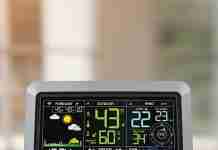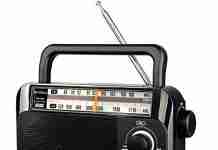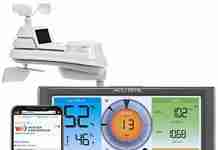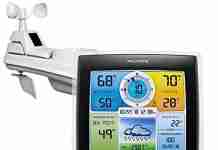In the fascinating world of meteorology, it’s natural to wonder how meteorologists gather the intricate details of weather patterns and forecasts.
Curiosity leads us to ask: do meteorologists use weather stations? Well, the answer lies in the essential role that weather stations play in their work.
These technology-filled havens of data collection serve as the backbone of meteorological research, providing invaluable information that helps meteorologists paint a comprehensive picture of the ever-changing atmospheric conditions.
So, let’s dive into the world of weather stations and uncover their vital significance in the science of meteorology.
Review contents
What is a weather station?
Definition
Weather stations are essential tools meteorologists use to collect data and monitor various weather conditions. It consists of several components and instruments that measure temperature, air pressure, wind speed, humidity, and precipitation. These measurements are crucial for understanding current weather patterns, predicting future conditions, and studying long-term climate trends.
Components of a weather station
Weather stations typically consist of the following components:
- Sensors and instruments: These devices measure different weather parameters, such as temperature, air pressure, wind speed, humidity, and precipitation. They are meticulously calibrated and designed to provide accurate and precise measurements.
- Data logger: This component records and stores the data collected by the sensors. It ensures the information is captured in real-time and can be retrieved for analysis and further processing.
- Communication system: Weather stations are often equipped with communication capabilities to transmit the collected data. This allows meteorologists to access the information remotely and share it with other weather monitoring networks or regional weather services.
- Power source: Weather stations require a reliable power supply to operate continuously. They may be connected to the electrical grid or powered by solar panels and batteries for remote or automated weather stations.
Why do meteorologists use weather stations?
Collecting data
Meteorologists rely on weather stations to gather essential data about various atmospheric conditions. By collecting accurate measurements of temperature, air pressure, wind speed and direction, humidity, and precipitation, meteorologists can comprehensively understand the current weather conditions.
Monitoring weather patterns
Weather stations play a vital role in monitoring weather patterns over time. By continuously recording and analyzing data, meteorologists can identify trends, track atmospheric changes, and detect recurring weather patterns. This information is crucial for predicting weather conditions and assessing long-term climate trends.
Predicting weather conditions
Accurate weather forecasts depend on reliable data collected by weather stations. Meteorologists analyze the data to identify patterns, correlations, and anomalies that help them predict upcoming weather conditions. By combining historical data with advanced forecasting models, meteorologists can provide forecasts that aid in planning and decision-making for various sectors, such as agriculture, transportation, and emergency management.
Types of weather stations
Automated weather stations
Automated weather stations have electronic sensors and instruments that collect data automatically. These stations are designed to operate without human intervention and provide real-time data. Automatic weather stations are commonly used in remote or inaccessible areas where continuous data collection is essential, but manual monitoring is impractical.
Remote weather stations
Remote weather stations are deployed in remote locations where human presence is limited or challenging. They are typically automated and powered by renewable energy sources like solar panels or wind turbines. Remote weather stations are crucial for monitoring weather conditions in remote regions, islands, oceans, and polar areas, providing valuable data for climate studies, research, and forecasting.
Instruments used in weather stations
Thermometer
A thermometer measures temperature, a fundamental parameter to understand weather conditions. It consists of a bulb filled with a liquid, usually mercury or an alcohol-based solution, which expands or contracts based on temperature changes. Meteorologists use various thermometers, including mercury thermometers, electronic thermometers, and infrared thermometers, to capture accurate temperature readings.
Barometer
A barometer measures atmospheric pressure, which is crucial for weather prediction. It helps meteorologists understand changes in air pressure, indicating the presence of high or low-pressure systems and whether conditions will be calm or stormy. Barometers can be mercury-based, aneroid, or digital, each with advantages and applications.
Anemometer
An anemometer measures wind speed and is essential for understanding wind patterns and forecasting potential weather events. It typically consists of rotating cups or propellers that spin when the wind blows. Meteorologists use anemometers alongside wind vans to determine both wind speed and direction.
Hygrometer
A hygrometer measures humidity levels in the air. It helps meteorologists understand moisture content and is crucial for predicting fog, dew, and other weather phenomena. There are various hygrometers, including psychrometers, capacitance hygrometers, and dew point hygrometers, each with specific measuring principles.
Rain gauge
A rain gauge measures the amount of precipitation over a specific period. It is vital for understanding rainfall patterns, which help meteorologists monitor droughts, floods, and water resource management. Rain gauges come in different designs, from simple cylindrical containers to more advanced tipping buckets or weighing precipitation gauges.
Weather vane
A weather vane, also known as a wind vane, indicates wind direction. It usually consists of a rotating arrow or a figure that shows the direction from which the wind is blowing. Weather vanes are essential for understanding wind patterns and, along with anemometers, help meteorologists monitor and predict weather conditions accurately.
How do meteorologists use weather stations?
Observational data
Weather stations provide meteorologists with observational data that forms the foundation for weather analysis and forecasting. By continually monitoring and collecting data from various instruments, meteorologists can assess current weather conditions, identify trends, and analyze historical weather patterns to make informed predictions.
Monitoring temperature
Weather stations equipped with thermometers allow meteorologists to accurately monitor temperature changes over time. This data helps identify daily temperature patterns, seasonal variations, and long-term climate trends. Temperature records are crucial for assessing climate change, understanding heatwaves and cold spells, and predicting temperature-related events.
Measuring air pressure
Weather stations with barometers help meteorologists monitor changes in atmospheric pressure. By analyzing pressure data, meteorologists can identify the development and movements of high-pressure and low-pressure systems, which lead to different weather conditions. Air pressure measurements are vital for predicting storms, wind patterns, and overall weather stability.
Wind speed and direction
Weather stations with anemometers and weather vanes provide meteorologists with essential information about wind patterns. By monitoring wind speed and direction, meteorologists can predict weather conditions related to wind, such as storms, gusts, or even tornadoes. These wind measurements are crucial for aviation, maritime operations, and severe weather warnings.
Humidity levels
Humidity measurements from weather station hygrometers assist meteorologists in gaining insights into moisture levels and atmospheric stability. Changes in humidity affect cloud formation, rainfall patterns, and the overall comfort levels for humans and animals. Accurate humidity data helps meteorologists assess fog potential, agricultural conditions, and heat index calculations.
Precipitation measurements
Rain gauges provide meteorologists with accurate precipitation measurements, such as rainfall or snowfall. Monitoring precipitation levels helps identify seasonal patterns, detect droughts or excessive rain, and assess water resource management. Precipitation measurements are crucial in flood forecasting, agricultural planning, and climate change studies.
Weather station networks
Regional weather stations
Regional weather stations form a network of interconnected stations within a specific geographical area. These stations collect data simultaneously and provide a comprehensive picture of regional weather conditions. Meteorologists use this data to understand weather patterns, assess impacts on local communities, and generate localized forecasts and warnings.
National weather services
National weather services gather data from a network of weather stations nationwide. They operate onon a larger scale and are critical in providing accurate weather information, forecasts, and warnings to the general public, industries, and government agencies. National weather services collaborate with regional weather stations and international meteorological organizations to ensure comprehensive coverage and reliable forecasts.
Advancements in weather station technology
Automated data collection
Advancements in weather station technology have led to automated data collection and transmission. Weather stations can now connect to the internet and instantly transmit real-time data to meteorologists and weather databases. This automation allows meteorologists to access data remotely, reducing the manual effort required for data collection and increasing overall efficiency.
Remote sensing
Remote sensing technology has revolutionized weather monitoring. Satellite-based remote sensing platforms have advanced sensors that capture weather-related data over vast areas. These satellites provide meteorologists with valuable information about cloud cover, aerosols, sea surface temperatures, and other atmospheric parameters. Remote sensing complements ground-based weather stations by expanding the coverage and enhancing the accuracy of weather analysis and forecasting.
Satellite technology
Meteorological satellites capture images and data from space, providing a unique perspective on weather systems and atmospheric conditions. These satellites track cloud patterns, monitor tropical storms, and detect temperature and moisture content changes. Meteorologists use satellite data to visualize weather systems, track the movement of batteries, and improve the accuracy of weather forecasting.
The role of meteorologists
Interpreting weather data
Meteorologists play a critical role in interpreting the data collected by weather stations. They analyze temperature, air pressure, wind speed, humidity, and precipitation measurements to understand how these factors interact and influence weather patterns. By combining historical data, satellite imagery, and computer models, meteorologists can provide accurate weather forecasts and assist with emergency preparedness.
Forecasting and predictions
Meteorologists use the data collected by weather stations to generate weather forecasts and predictions. They can predict future weather events by analyzing historical weather patterns and current conditions, such as storms, heat waves, or cold fronts. Weather forecasts help individuals, businesses, and governments make informed decisions, plan activities, and take necessary precautions, minimizing potential risks and maximizing safety and efficiency.
Challenges in weather forecasting
Accuracy
Weather forecasting relies heavily on accurate data from weather stations. However, challenges remain in achieving perfect accuracy due to limitations in data collection, processing techniques, and the complexity of atmospheric phenomena. Meteorologists continuously strive to improve accuracy, refine forecasting models, and incorporate new technologies to minimize errors and enhance predictability.
Timeliness
Timely weather information is crucial for public safety, emergency management, and decision-making across various sectors. Delays in data transmission or the availability of up-to-date weather information can impact the effectiveness of forecasts and warnings. Meteorologists and weather station networks work together to ensure timely data collection, analysis, and dissemination, providing the most current and relevant weather information to the public and stakeholders.
Data analysis
Weather station networks generate vast amounts of data that require analysis and interpretation. Processing and analyzing this data can be time-consuming and resource-intensive. Meteorologists utilize advanced data analytics techniques, machine learning algorithms, and artificial intelligence to efficiently automate data analysis and extract valuable insights. Continuous improvements in data processing methods help meteorologists maximize the usefulness of weather data for forecasting and climate studies.
Conclusion
Weather stations are indispensable tools for meteorologists in understanding, monitoring, and predicting weather conditions. They provide a wealth of data on temperature, air pressure, wind, humidity, and precipitation, which is instrumental in forecasting accurate weather conditions and supporting decision-making in various sectors.
As technology advances, weather stations, and meteorologists will work hand in hand to refine forecasting models, improve data collection and analysis techniques, and enhance our understanding of weather and climate trends. This collaboration will enable us to better prepare for and adapt to the ever-changing nature of our atmosphere.



































